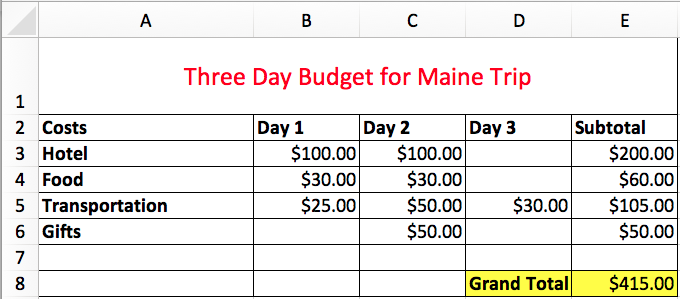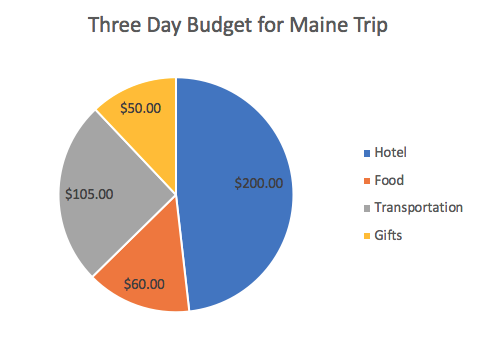Learn Easy Steps: Create a Budget
Learn: Easy Steps
Activity Card: Create a Budget
How will you ensure that your expenses do not exceed what you planned to invest or spend? You can create a budget to plan your expenditures and earnings. As a family, you can plan an expenditure budget for a holiday trip. For a business, you can make a budget for a business trip, to calculate the start-up costs of a new project, or to provide an estimate of profits and expenditures.
Look at the following example:


As in the example above, a Budget created on the computer typically has:
- A worksheet with Information about the items
- Sum functions
- A pie chart that shows the relationship of each item’s expenses to the grand total
Steps to Create a Budget
Type Headings on Your Worksheet
- Start the spreadsheet tool, such as Microsoft Excel or Google Sheets, and open a new, blank worksheet.
- Type a worksheet title in cell A1. Change the column widths or merge cells as needed.
- Type “Costs” in cell A3. Then, in the cells directly below, type the items for expense. Make sure you put each item in a different cell. Change the column widths or merge cells as needed
- Type “Day 1” in cell B3, “Day 2” in cell C3, “Day 3” in cell D3.
- Save your work. Make sure you save your work after every couple of steps you complete.
Type Estimated Expenses
- In the cells below the column headings, type the amount of money that a person could expect to spend each day on the items you typed in Column A. Make sure you type this information in the correct cells.
- Save your work.
Show Numbers as Currency
- Format the numbers in columns B, C, D, and E so they look like money or currency.
- Save your work.
Insert Formulas
- In cell E3, type “Subtotal.” Then, in the cell below, insert a Sum function to add the Day 1, Day 2, and Day 3 costs for the first item in your list.
- Fill the Sum function down so there is a subtotal for each cost in column A.
- Click the empty cell two rows below the last cost amount in column D. Type the words “Grand Total,” and change the column width as needed.
- In the empty column E cell to the right, insert a Sum function that totals all of the item subtotals in the final column. This is the total amount of money that one person can plan on spending while visiting another town for three days.
- Save your work.
Change the Look of the Worksheet
- Change the look of information however you wish. You might want to make the worksheet title, the column labels, the cost names and the grand total information stand out.
- Try different alignment options to see which one makes the information look good. If needed, make the columns wider.
- Save your work.
Insert a Pie Chart
- Select the cost names in column A, hold down the Control key, and then select the subtotal costs in column E. Then, insert a pie chart to show the relationship of each type of cost to the grand total. Be certain to title your chart and add the values as data labels. When you are done, save the chart as a new sheet.
- Save your work.
Budget Challenge (Optional)
- Select all of the rows containing information (from row 3 to the grand total row). Change the look of the table by applying an AutoFormat. Change the look of the words and numbers in the chart. You can also change the colors of the different pie slices. Note: When applying the AutoFormat, avoid selecting the top row containing the worksheet title. Explore a few Auto Formats before picking the one you want to use.
- Save your work.
Review Your Work
Look over your budget worksheet. Make sure it has the following elements:
- A worksheet with information about your items
- Sum functions
- A pie chart that shows the relationship of each item’s expenses to the grand total
If any elements are missing, add them to the worksheet now. You should also make other desired changes. Remember to save your work when you are finished.
Optional: Print Your Budget Worksheet
- Preview your budget worksheet before you print it. Set up the document so it prints sideways (landscape).
- Print your budget worksheet.
- To print more than one copy, click the up arrow in the Number of copies list. Note: By default, the number of copies to be printed is 1. Just click on the up arrow to print more than one copy. Click on the down arrow to print fewer copies.
- Click OK or click Print.
Terms of Use and License
Terms of Use
These resources provided by Intel are 'open' and are available for educational use. Many hold Creative Commons licenses that allow them to be repurposed, modified and adapted for a diverse array of local contexts.
Each resource has one of three conditions of use labels. These at-a-glance labels can help you quickly distinguish whether a resource can be changed or shared without further permission required. In addition, you can find the specific license or terms of permitted use for each resource.
- Remix and Share Your remixing, redistributing, or making derivatives works comes with some restrictions, including how it is shared. Includes Creative Commons Attribution Share Alike (CC BY-SA), Creative Commons Attribution NonCommercial Share Alike (CC BY-NC-SA), Creative Commons Attribution NonCommercial (CC BY-NC), GNU Free Documentation License (GFDL);
- Share Only Your redistributing comes with some restrictions. Do not remix or make derivative works. Includes Creative Commons No Derivatives (CC ND).
- Read the Fine Print Everything else. All Rights Reserved. US-based educators have certain permissions under Fair Use and the TEACH Act. Includes educational and personal uses of copyrighted materials, custom licenses and terms, permission to print only, unknown restrictions, and any other redistribution restrictions of the DMCA and of your own country.
License
All Intel Content is protected under U.S. and international copyrights. Intel owns and retains all rights, title and interest, including all rights under copyright, in and to all Intel Content. Your rights to use, share and adapt Intel Content under the Creative Commons (“CC”) License are merely those of a non-exclusive licensee, and you do not acquire copyright ownership with respect to any Intel Content.
Except as expressly otherwise noted, all Intel Content (including Intel Curriculum Material) is made available to Users in accordance with the Creative Commons Attribution-Noncommercial 3.0 Unported (CC BY-NC) License (http://creativecommons.org/licenses/by-nc/3.0/), as amended and updated by Creative Commons from time to time (the “CC BY-NC License”), which is incorporated herein by this reference.
The CC BY-NC License allows you to freely share and adapt Intel Content, provided that:
- You give proper attribution to Intel in the manner specified by Intel, but not in any way that suggests that Intel endorse you or your use;
- You may not use, copy, reproduce, perform, display, distribute, transmit, disseminate, modify, adapt, create derivative works from, or otherwise exploit Intel Content for commercial purposes, including for commercial advantage or private monetary compensation;
- For any reuse or distribution of Intel Content, you must make clear to others the CC BY-NC License terms (the best way to do this is with a link to http://creativecommons.org/licenses/by-nc/3.0/); and,
- You comply with all other requirements as may be specified in the CC BY-NC License. The CC BY-NC license supersedes and replaces any Creative Commons license previously adopted by Intel for Intel Content.
NOTE: Notwithstanding the above, the CC BY-NC License does not apply to photos, images and other materials contained in Intel Content which have been licensed by Intel from Shutterstock.com and/or other commercial stock photo/image agencies (you can easily identify such a photo or image by looking at the credit embedded within or associated with the photo or image) (each, a “Licensed Stock Photo”). You are allowed to retain a copy of a Licensed Stock Photo for your own personal, non-commercial use only, BUT (i) you may not modify, alter, adapt, or otherwise create any derivative work from a Licensed Stock Photo and (ii) you may not distribute, transmit or disseminate a Licensed Stock Photo or any copy or derivative work thereof, to any third party, whether by itself, as part of Intel Content, as part of your Curriculum Contributions, or otherwise.
If you wish to use Intel Content for commercial purposes, you must contact Intel to enter into a separate license agreement governing commercial use of Intel Content.
If you do not agree to the terms of the CC BY-NC License, please refrain from using Intel Content in any manner, including downloading, copying, reproducing, printing, editing, modifying, distributing or transmitting such content, in any media or by any means, whether now known or hereafter developed. If you accept the terms of the CC BY-NC License and proceed to use any Intel Content, then any breach or violation by you of the CC BY-NC License will automatically constitute a violation of the TOU and may subject you to liability to Intel for copyright infringement. Also, to the extent you have violated the CC BY-NC License and made modifications or improvements to, or have prepared derivative works based upon, Intel Content or have otherwise incorporated Intel Content into your own content for commercial purposes, your violation of the CC BY-NC License will automatically subject such modifications, improvements or derivative works by you, or your own content that is mixed with Intel Content, to a perpetual, royalty-free, worldwide license to Intel, and Intel may, in its sole discretion, elect to exercise the foregoing license in addition to or without prejudice to any other remedies available.
2018 Based on materials originally developed by IntelⓇ Corporation
